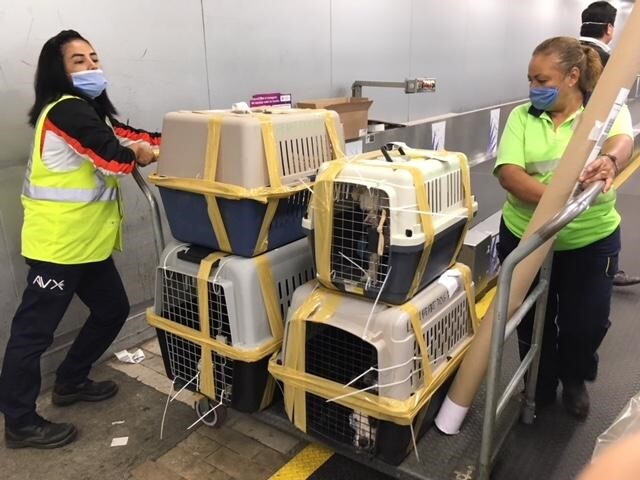Occasionally we hear from people who have adopted a dog or cat while visiting Guanajuato and want to take it home with them to the United States. They ask us what preparations they need to make. Here are a few recommendations.
The requirements differ, depending upon whether you are planning to travel by car or plane, and they are subject to change. Therefore, you should check the U.S. government’s current requirements, which are posted on the U.S. Centers for Disease Control website, for the latest information. The information offered here is based partly on information provided by that site and partly on the experiences of friends who have traveled to the United States with dogs and cats.
According to the CDC’s website (as of January of 2023), “Dogs that have NOT been in a high-risk country in the past 6 months may enter the United States through any port of entry, and importers are NOT required by CDC to present rabies vaccination documentation. However, when your dog enters the United States, you must provide a written or verbal statement your dog has only been in a country NOT at high risk for at least 6 months or since birth if under 6 months of age.” Mexico is NOT a country with a high risk of dog rabies.
The CDC’s regulations for cats as of September 22 are as follows: “A general certificate of health is not required by CDC for entry of domestic cats into the United States, although some airlines or states may require them. However, cats are subject to inspection at ports of entry and may be denied entry into the United States if they have evidence of an infectious disease that can be transmitted to humans. If a cat appears to be ill, further examination by a licensed veterinarian at the owner’s expense might be required at the port of entry.
“Cats are not required to have proof of rabies vaccination for importation into the United States. However, CDC recommends that all cats be vaccinated against rabies, and your US destination may have additional requirements.”
Driving with a dog or cat to the U.S. is much easier than taking or sending one on an airplane, but in either case we recommend that you have a valid rabies vaccination certificate that includes the vaccine vial sticker showing the lot number and a rabies serologic titer result from a licensed veterinarian. Note: not all veterinary clinics in Guanajuato have licensed veterinarians on their staff. Contact us (amigos@amigosanimalesgto.org) if you would like us to recommend a licensed vet.
Whether you are driving or flying, we also advise you to have proof of a dog’s recent immunization against other serious communicable diseases such as parvovirus and distemper, as many dogs acquired in Mexico are infected with those viruses. The CDC recommends that you bring all your dog’s documents with you when you travel to the United States.
Driving with a pet to the U.S.
Most people have no difficulty taking a dog or cat across the northern border of Mexico when traveling by car. When stopped by U.S. border patrol, you may be questioned about how long your dog has been in Mexico. If your dog has only been in Mexico and appears to be healthy, then you should be allowed to proceed without his having to be quarantined.
If you are traveling with a pet during extremely hot or cold weather, be mindful of how quickly the interior temperature of a vehicle can become dangerously hot or cold when you leave it for even a few minutes–for example, at a rest stop. While driving in hot weather, if your air conditioner is not very effective, you can help a pet keep cool by covering it with a towel that has been soaked in cold water.
Flying a pet to the U.S.
To fly with or to send a pet to the U.S., you will need to find an airline and flight that will accommodate your pet. The León International Airport serves many more flights than it used to, but it may be necessary to fly with a pet from Guadalajara, Mexico City, or even Puerto Vallarta. Some airlines allow small pets (cats and small dogs) to ride in the passenger cabin. Your pet must be kept in a soft carrier that will fit under the seat in front of you.

If your dog cannot ride in the cabin with you because of his or her size, you may need to send him on a separate flight from the one you are planning for yourself, as cargo areas on smaller planes may be too small. The airline will require that your dog be flown in a crate large enough for him to be able to stand up and turn around inside it. Be sure to confirm that the crate size is acceptable before the dog’s flight date. This may require a trip to the cargo office of your airline with your dog and his crate. Cargo offices of some airlines serving Guanajuato are in the city of León.

You may be asked to pay cash for the dog’s flight when you visit the airline’s cargo office. If so, be sure to obtain a signed receipt, and challenge the amount you have paid if it’s greater than what you have been quoted by the airline. Your author once was required to pay nearly twice the fee quoted by the airline, and in cash, for a dog’s flight in the cargo hold.
Be aware of blackout dates if your pet’s itinerary requires changing airplanes before arriving at its destination. Some airlines refuse to fly pets during extremely high or low temperatures, because pets left on the tarmac for even brief periods while baggage is being reloaded can die of exposure before being put onto their continuing flights. If you are planning to fly with a pet in the winter or summer, you may have to leave him or her with friends for a while, and then arrange for him to be sent to you when it’s safe for him to fly.
Finally, get your pet used to being in a crate or carrier before you travel. This will reduce his stress somewhat. Give him a hearty meal and water 4 hours before departure time but not just before the flight. Try to visit your pet if you have a layover during your travel north. It will comfort both of you.
